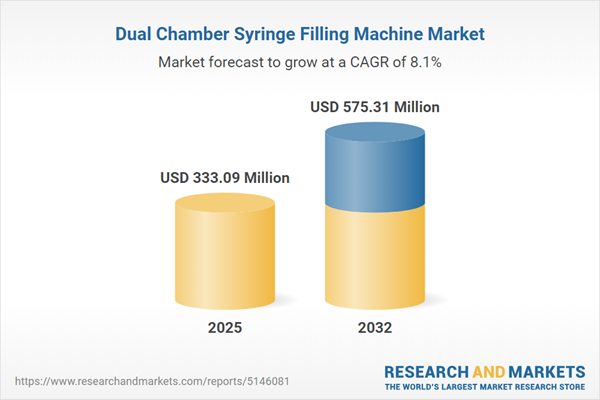Speak directly to the analyst to clarify any post sales queries you may have.
Senior decision-makers in the pharmaceutical and medical device industries are increasingly challenged by emerging regulatory demands and greater process complexity. To remain compliant and efficient, professionals are prioritizing reliable, innovative solutions—driving demand for advanced dual chamber syringe filling machine technology that streamlines operations, supports evolving drug delivery trends, and underpins sustainable growth strategies.
Market Snapshot: Dual Chamber Syringe Filling Machine Market Size and Growth
The dual chamber syringe filling machine market currently stands at USD 307.75 million and is set to expand at an 8.13% compound annual growth rate (CAGR), reaching USD 333.09 million in 2025 and projecting to USD 575.31 million by 2032. This growth is fueled by increasing adoption of automation within manufacturing environments, strengthened production requirements prompted by shifting global regulations, and an industry-wide move toward advanced drug packaging systems. Leading manufacturers are not only scaling infrastructure but also expanding product portfolios, enabling clients to respond more flexibly to operational and compliance needs. Additionally, robust regulatory activity and innovation within sterile processing motivate continuous investment across major geographic regions.
Scope & Segmentation of the Dual Chamber Syringe Filling Machine Market
This analysis covers the strategic market divisions and operational advancements shaping dual chamber syringe filling machine adoption worldwide:
- Automation Types: Fully automated systems enhance efficiencies for large-scale pharmaceutical manufacturers focused on high-volume, continuous operations. Semi-automated solutions support organizations seeking adaptive integration, beneficial for facilities with unique or varying production demands.
- Material Types: Glass syringes remain preferred in applications where chemical stability is crucial—such as biologics manufacturing—while plastic syringes are recognized for enabling cost control and deployment across fast-changing healthcare scenarios.
- End User Profiles: Contract manufacturing organizations (CMOs) leverage modular filling equipment to swiftly scale or adjust to new client requirements. Hospitals, research institutions, and biopharmaceutical producers depend on these solutions to uphold safety and process reliability.
- Regional Coverage: Established markets in the Americas and Europe benefit from stringent standards and ongoing capital investment, ensuring steady rollout and adoption. Rapid expansion is observed in Asia-Pacific and Latin America, spurred by the localization of advanced manufacturing technology and regulatory modernization in these areas.
- Leading Manufacturers Covered: The report reviews active providers including Schott AG, Nichrome India Limited, Maquinaria Industrial Dara S.L., NJM Packaging Inc., Vetter Pharma-Fertigung GmbH & Co. KG, Dietrich Engineering Consultants, Harikrushna Technopride Pvt. Ltd., Marchesini Group S.p.A., TurboFil Packaging Machines LLC, Stevanato Group, and Syntegon Technology GmbH, highlighting roles in technology scaling and operational alignment to industry needs.
Key Takeaways for Senior Decision-Makers
- Modern syringe filling machine platforms increase both production throughput and regulatory control, allowing companies to enhance sterile processing while addressing escalating compliance expectations worldwide.
- Highly modular designs promote efficient scale-up—from pilot runs to commercial production—enabling organizations to rapidly address new drug launches and expand product portfolios as pipeline demands evolve.
- Integrated digital systems, such as traceable batch records and process automation, facilitate smoother regulatory inspections and open up improved transparency across healthcare and manufacturing supply networks.
- Predictive maintenance technologies, including AI-driven diagnostics and digital twins, help optimize equipment usage, enabling preemptive servicing and minimizing costly production interruptions.
- Versatile machinery options support rapidly shifting project requirements for both contract manufacturers and in-house production teams, helping organizations adapt to fluctuating market and service needs.
- Diversified sourcing and continuous supply chain monitoring allow for resilient operations, helping businesses mitigate risks tied to regulatory changes or shifting economic environments.
Tariff Impact: Navigating the 2025 Tariff Changes
Forthcoming U.S. tariff adjustments affecting essential machine components and sensors are prompting manufacturers to revisit procurement strategies. Companies are deepening relationships with domestic suppliers and expanding international sourcing as a way to maintain cost stability. Enhanced auditing and updated inventory management practices help organizations stay agile and compliant, even as supply conditions or regulations become more dynamic.
Methodology & Data Sources
This report draws on insights from engineers, purchasing managers, and quality assurance leaders. Conclusions are supported by current academic research, verified company records, and established regulatory documentation, offering decision-makers targeted intelligence for sterile drug device manufacturing.
Why This Report Matters: Strategic Insights for the Dual Chamber Syringe Filling Machine Market
- Supports informed strategic planning by providing up-to-date market intelligence, analysis of regulatory impacts, and effective response techniques in sterile drug delivery system adoption.
- Assists with supplier selection and benchmarking, allowing organizations to identify best practices that reduce operational risk and streamline compliance efforts in evolving environments.
- Delivers essential insights to help executive teams manage rapid changes in manufacturing processes and procurement, supporting continuity and resilience in critical business operations.
Conclusion
Prioritizing adaptable technologies, durable supplier relationships, and consistent compliance strategies equips organizations to achieve sustainable success in the dual chamber syringe filling machine market. Continued focus on operational improvements and investment is vital for ongoing leadership in sterile systems manufacturing.
Additional Product Information:
- Purchase of this report includes 1 year online access with quarterly updates.
- This report can be updated on request. Please contact our Customer Experience team using the Ask a Question widget on our website.
Table of Contents
3. Executive Summary
4. Market Overview
7. Cumulative Impact of Artificial Intelligence 2025
Companies Mentioned
The companies profiled in this Dual Chamber Syringe Filling Machine market report include:- Schott AG
- Nichrome India Limited
- Maquinaria Industrial Dara, S.L.
- NJM Packaging Inc.
- Vetter Pharma-Fertigung GmbH & Co. KG
- Dietrich Engineering Consultants
- Harikrushna Technopride Pvt. Ltd.
- Marchesini Group S.p.A.
- TurboFil Packaging Machines, LLC
- Stevanato Group
- Syntegon Technology GmbH
Table Information
| Report Attribute | Details |
|---|---|
| No. of Pages | 193 |
| Published | October 2025 |
| Forecast Period | 2025 - 2032 |
| Estimated Market Value ( USD | $ 333.09 Million |
| Forecasted Market Value ( USD | $ 575.31 Million |
| Compound Annual Growth Rate | 8.1% |
| Regions Covered | Global |
| No. of Companies Mentioned | 12 |









